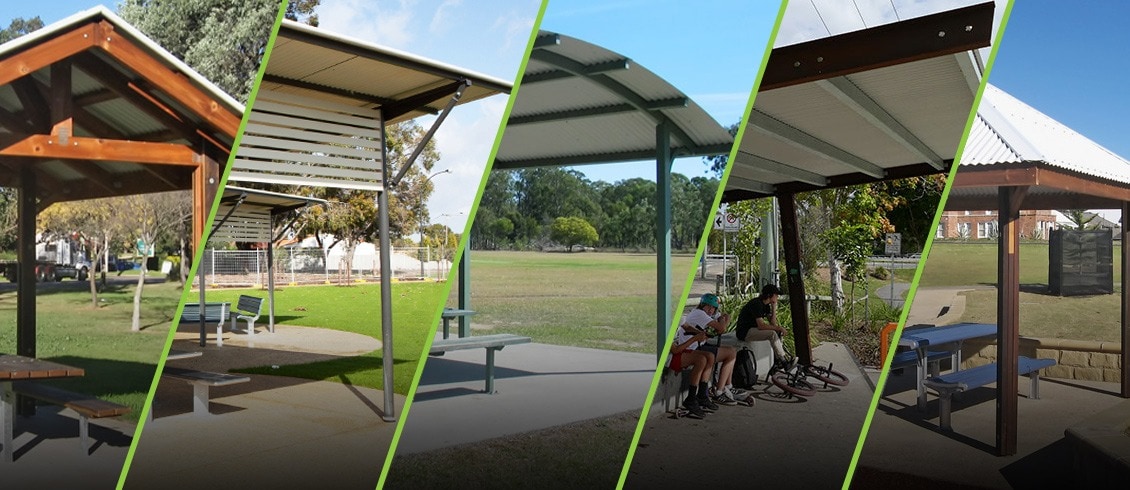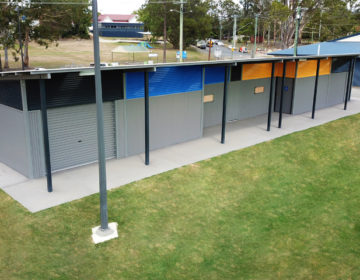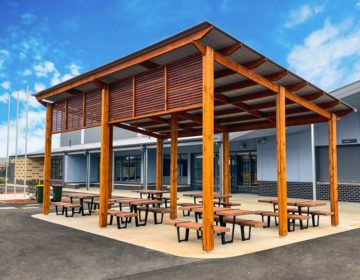
As standard, Landmark offer eight different types of roofs for park shelters and restrooms – cantilever, curved, gable, gazebo, marquee, pyramid, skillion and wave.
While many choose the roof type for their park structure based on preferred aesthetics, sometimes there are some practicalities that influence the decision.
So, what are the pros and cons of four specific roof types?
Gable roof
Also known as pitched or peaked roof, gable roofs are the most traditional of all shapes.
Pros: Gable roofs shed water easily, provide more vertical space underneath and allow good ventilation. Their inherently simple design makes it easy to build them and cheaper than more complex designs.
Cons: Gable roofs can be problematic in high wind and hurricane areas, particularly if the frames are not properly constructed with adequate supports (Landmark is highly experienced at building gable roofs for cyclonic regions). If not built to specification, high winds can cause materials to peel away from gable roofs, for example, if there is too much of an overhang, winds can create an uplift underneath and cause the roof to detach.
Skillion roof
Skillion is a single, sloping roof, which could be thought of as half of a pitched roof, or as a more angled flat roof.
Pros: Skillions are easy to assemble and use much fewer building materials than other roof types. Their pitch allow water to easily run off, which makes them excellent for high rain regions. They can also be used purely for design purposes to add architectural interest and aesthetic appeal.
A skillion roof also offers a great uninterrupted area for the installation of solar panels.
Cons: Structures using a skillion roof can have problems in high wind areas if not built to the correct standards.
Curved roof
A curved roof is much like the skillion, but the planes are curved. It is very modern and provides a unique, creative roof design. The amount of curve can vary from slightly curved up to an arch shape.
The best material for curved roofs is metal. It will bend and shape into any form, plus the maintenance will be greatly reduced.
Pros: Curved roofs are aesthetically pleasing and a way to have a structure unique. They also provide subtle shapes inside the structure as well.
A curved roof can be customized to be advantageous to the region the structure is being built. For example, in high wind areas, a roof with a lower slope would be more durable than one with a higher slope. While in areas that receive more rain can have more of an arch to allow water to run-off.
Cons: The cost of a curved roof will depend on the complexity of the design.
Cantilever
A cantilever structure requires support posts only on one side, with the load contained with the frame.
Pros: With posts only one onside, cantilevers offer great accessibility to furniture underneath. Furniture can be installed closer to the edge of the roof line. Cantilevers are ideal for shelters where uninterrupted views are a priority.
Landmark are also able to offer cantilever shelters with insulated roofing.
Cons: Because of the stress factors within cantilever shelters, there are no options in materials available for their construction. It’s steel or nothing for the posts and roof frame.
Pyramid roof
A pyramid roof is a type of hip roof. All four sides come to a point at the top of the roof. There are no vertical sides or gables.
Pyramid roofs are mostly used for smaller shelters and restrooms.
Pros: A pyramid roof is extremely resistant to strong winds. This makes it an excellent architectural choice for cyclonic regions.
The slope provides extra space for ventilation, and shade.
Cons: The cost of pyramid roofs can be a little higher due to the complexity of the design.
Landmark understands that when it comes to selecting the right roofing type for your open space structure, that there are multiple factors to consider. The Project Consultants and design team are more than happy to assist you to make the right choice.



